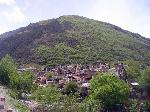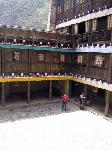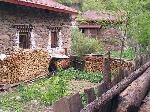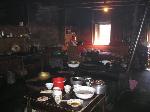- Getting around Lijiang. Dont stay in the Old Towns more than 2 days, there is nothing to do. KRISS Oct 9, 2013 05:46
- 2013 Beijing Temple Fair BENNYLAU Feb 26, 2013 03:29
- Malaysian traveling from KUL - LAX vis Shanghai PVG ZATI_DY Jan 3, 2013 20:15
Heart of a Stone House _ Zhuokeji
- Views: 5768
- |Vote: 0 0
- |Add to Favorites
- |Recommend to Friends
The previously steep hill sides rise a little more gently skyward as the valley opens out. A cluster of geometric grey stone block houses sits comfortably on the slope smartly dressed in their distinctive white washed window frames, corner and roof trims. Colourful prayer banners flutter gently in the breeze above the rooftops. The village of orderly three story stone houses climbs the forested slope above the riverbank, in sharp contrast and yet perfect harmony with the backdrop of greens and blue. The sun lingers just a little longer in the valley floor – this afternoon casting a golden glow over an already magical scene.
All down the valley we have seen the similar homes of the Zang ethnic minority clinging to the mountainside surrounded by small patches of flat or gently sloping ground. With more than one hundred homes this is by far the largest village we have seen all afternoon and where we plan to spend our time. The chieftain’s palace – the Tu Si – dominates the scene perched above the junction of two swiftly flowing streams. We’ve been following the larger from its source in the snow covered mountain pass a few hours to the north. A second smaller stream tumbles vigorously past the village to join the Suomo River in the shadow of the Tu Si.
Beside the palace stands what remains of a square watchtower, once the largest in the region befitting the palace home of the Chieftain. Today it stands a solemn and diminutive one third of its original height. While no longer the centre of government in the region, the village still commands attention with its interesting history. During the height of the Civil War in 1935, Mao’s Red Army bivouacked for almost a year in the valley. Mao Zedong, Zhou Enlai, Zhu De and other key generals and strategists spent a week camped out in the palace on their way north to the eventual security of Yanan. Much of Tusi was destroyed during the fighting that followed.
Having read Anthony Grey’s epic novel ‘Peking’ which chronicles the fate of an unlikely foreigner caught up in China’s civil conflict and the Long March, I’ve long been curious to see for myself just where they marched. After traveling several days across Aba County in the comfort of local buses it seems inconceivable how any of his men managed to cover this inhospitable terrain on foot and in winter much less survive at all. Needless to say the Tusi has since been restored and is a major tourist attraction in the district surrounding the county seat of Maerkang.
Tourism has descended lightly on Zhuokeji. Even during the May and October holidays it is relatively quiet and largely unaffected by tourists. Apart from a couple of small restaurants and the absence of tacky souvenir shops, one could easily pass by this unassuming village. Maerkang locals, in on the secret, enjoy the atmosphere and scenery of the place coming for lunch or dinner or simply to pass the time drinking tea, playing cards or mahjong.
A tour of the Tu Si takes around an hour and offers a fascinating insight into the lives and community of the people. The five-story building standing with its back to the bitter north winds is constructed entirely of timber, stones and mud. The roof is tiled with sheets of slate. Much of the ground floor is earthen or flagged with stone and is home to the storerooms, kitchens, tradesmen and artisans workrooms, including a saddler, silversmith, blacksmith, cloth maker and carpenter.
The second floor is the family home, the luxurious private living quarters of the Chieftain, his wife and their personal servants as well as a vault and a grand kitchen and dining room for entertaining. The Chieftain was responsible for governing the affairs of this sprawling rural community, much of which it still well hidden in the maze of beautiful mountains and valleys surrounding Maerkang. The third floor houses meeting, council and dining rooms where community affairs were taken care of as well as the spacious and opulent opium smoking room.
The two upper floors house a place of worship and private rooms for the monks and servants who lived and worshipped here. The two lower levels entirely circle the central courtyard facing the southeast. While the three upper levels open to the southern sun warming the Tu Si and giving a commanding view of the entire village across the stream.
The Zang minority of Zhuokeji belongs to the non-nomadic Jairong Tibetans of western Sichuan and religion plays an important role in their lives. Long strings of prayer flags span the Suomo adjacent to the bridge releasing countless prayers as they tug and sway in the breeze blowing down the valley. This physical and spiritual harmony of breeze and flowing water permeates the valley and the villages. During the special holidays, a group of elders from Maerkang dance and sing traditional songs for visitors in the courtyard of the Tu Si several times each day. Colourfully clad in traditional clothing their performance is eerily spiritual, full of joy and love for one another. Between shows they play cards, chat and laugh together.
They are only too happy to share this joy with us and readily engage in conversation. With so many of the young leaving these days to go off to university or work in large cities hours away by bus I also begin to wonder how many of their traditions will disappear with this engaging generation. During our stay we are constantly asked whether we are American. Half our number being so it is nice to answer in the affirmative but it eventually begins to irritate until one of the older men expresses his heartfelt gratitude for the assistance of America during the war with Japan. He was only a young boy but he remembers and now I understand.
Much of Zhuokeji’s attraction lies in the fact that it is largely undiscovered. With only one small road into the village it is a peaceful place that has not changed much in the years since Mao passed by and seems in no hurry to embrace the modern world that is tapping gently on its door. One afternoon we watch amazed and surprised at the rare sighting of a horse caravan. As quickly as they appear – and before either of us can wield a camera – this string of wiry pack horse disappears at a clipping pace. There is little else to do but enjoy the serenity, simplicity and beauty of this place.
To the left and the right the dry stone walls of houses rise from the midst of small vegetable gardens, stone flagged stairs climb the slope between the houses and purple iris smile brightly from the top of the rock wall and neat stacks of firewood as we pass by. In each house the ground floor is reserved for storage and animals. The second floor is the living area with a large and brightly decorated living room for entertaining guest also doubling as extra bunks. At the back of the second floor is the most important room, the warmest in the house – the kitchen and family dining room where the fire never goes out. Large pots of water stand near the heath, and two skylights let in a little extra light.
Adjoining these two major rooms are several small bedrooms, which members of a multi-generational household can call their own. The top floors of some homes have been converted to guestrooms with two or more beds in each. Another special feature of these large stone houses is the outdoor lavatory – but not quite an outhouse. Skillfully crafted of timber, these rooms with a view usually extend from the upper floor at the end of a short hallway with an external door. A small wooden shoot drops away beneath the floor and the waste is collected in an open trap on the ground below. Some of the newer homes have one on each of the upper floors. Corn, sunflowers and walnuts drying on the attic floor attract rats and mice at night.
On the last evening of our stay I lean over the garden fence chatting with the neighbour and after showing her my digital photos she invites me to come into her house. She has been friendly and helpful keeping an eye on our bags when we first arrived. It is just on dusk as I follow her through her front gate, across the small courtyard and into the dim interior of her home. We climb the stairs to her living floor and go outside to wash our hands on the balcony where she offers me a bunch of grapes right off the vine rambling all over the roof garden. We chat some more. She lives alone most of the time – her son is in Chengdu at University and her husband only returns home on weekends from Maerkang where he works, just seven kilometers away.
The villagers here seem prosperous and content with life. To our delight we are not harassed by villagers as often happens, begging us to buy something or to stay with them. We stumble across a small guesthouse that has other guest for the afternoon. Wu Yi quietly negotiates a price for dinner, bed and breakfast and we choose a lovely room, one of three on the top floor of their home. It is bathed in afternoon sun with a spectacular view over the valley and the Tu Si. In the living room is a feast of fruit and seeds laid out for all the guests. The others, playing cards in the garden under the walnut trees leave after dinner. The sky is full of stars tonight and it is quiet. A thin trail of smoke from a kitchen fire drifts lazily on the night breeze. I return here less than six months later to spend a little more time in the same home, in the same room and enjoy so much more of the same peace and tranquility.
Getting there:
Just 7 kms east of Maerkang.
Local bus from Maerkang runs along the river and can be flagged down almost anywhere in town. Y5 each way
Long distance buses to and from Maerkang will drop off and pick up at the intersection in Zhuokeji village if they have seats.
Long distance bus from Xiaojin in the south 3/4 hours.











 Copyright © 1998-2025 All rights reserved.
Copyright © 1998-2025 All rights reserved.
1.
Mar 10, 2008 06:28 Reply
JOANNEL said:
It's hard to imagine that such a perfect and unaffected place still exists on earth sn't it!!
Joannel